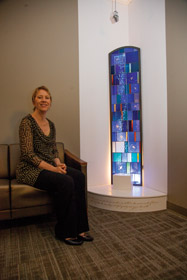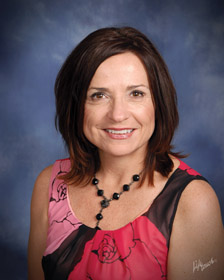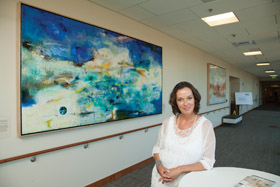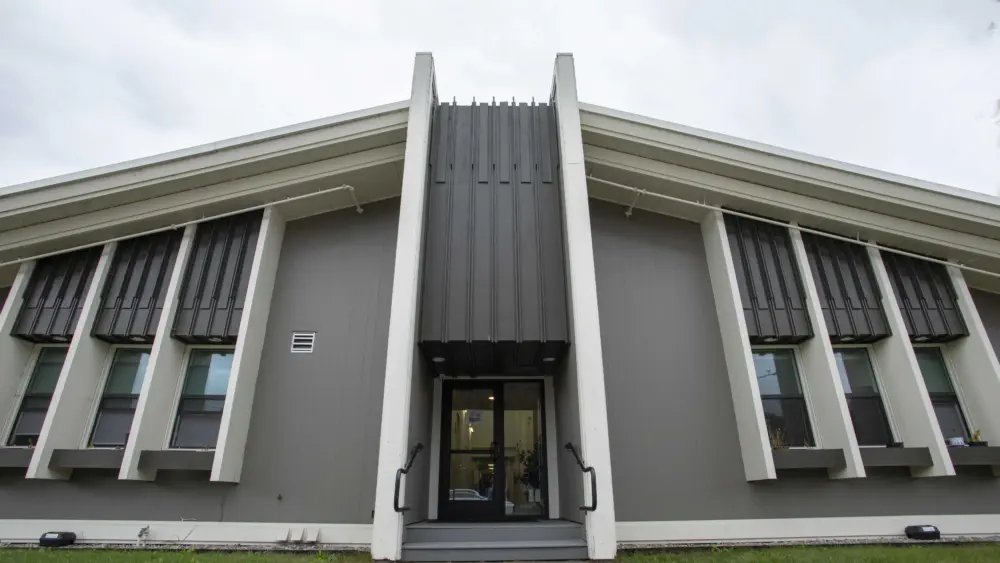A final look before Sutter Santa Rosa Regional Hospital opens its doors to the public
 In ancient Greece, the original facilities for the ill were temples, dedicated to healing gods, that surrounded patients with nature, music and art to restore harmony and promote healing. Asclepius was the god of healing, while his daughter, Hygieia, was the goddess of health and well-being. The first “asclepeion,” or healing temple, was in Epidaurus; it was a sanctuary and the most celebrated healing center of the classical world. It was designed to promote harmony of mind, body and spirit, which was embedded into the structure itself, says Wayne Jonas, M.D., chief executive officer of the Samueli Institute, an organization based in Alexandria, Va., that studies the science of healing.
In ancient Greece, the original facilities for the ill were temples, dedicated to healing gods, that surrounded patients with nature, music and art to restore harmony and promote healing. Asclepius was the god of healing, while his daughter, Hygieia, was the goddess of health and well-being. The first “asclepeion,” or healing temple, was in Epidaurus; it was a sanctuary and the most celebrated healing center of the classical world. It was designed to promote harmony of mind, body and spirit, which was embedded into the structure itself, says Wayne Jonas, M.D., chief executive officer of the Samueli Institute, an organization based in Alexandria, Va., that studies the science of healing.Over the years, as medical technology has advanced and care has become more sophisticated, health care facilities have transformed into efficient, box-like structures, with bland color schemes, hallways that echo and shared patient rooms that are sometimes cramped. According to Jonas, this system was successful in promoting a laboratory-based approach to health care to effectively treat disease for the last 150 years. Today, however, there’s been a dramatic change in patient needs. We’re now faced with chronic diseases, 70 percent of which is a result of lifestyle choices. Says Jonas, “We built a system that effectively treats disease, but doesn’t promote well-being.”
There are two ways to provide care, according to the Hippocratic school of thought regarding medicine, he continues. “First, eliminate disease. Second, tap in and enhance the patient’s healing capacity. We’re trying to return there and pay attention to what promotes and creates health, which has been put on the back burner for the past 100 years. When we talk about integrating cures with health creation, we’re trying to return to these concepts.”
Harmony of mind, body and spirit
There’s a paradigm shift nationwide as health care providers are incorporating features that promote harmony of mind, body and spirit into hospital design.
The new Sutter Santa Rosa Regional Hospital began as a result of California’s hospital seismic-safety law (SB 1953), which requires hospitals to meet new earthquake standards. And to support the environment and human health, the hospital was designed using green building practices. All decisions were made aiming for a Silver LEED certification, but there’s a high probability the hospital will meet LEED Gold certification this autumn. If that happens, Sutter Santa Rosa Regional Hospital will be the first to attain US Green Building Council (USGBC) LEED Gold certification for a hospital built from the ground up in California. (Leadership in Energy and Environmental Design, or LEED, is a set of rating systems for the design, construction, operation and maintenance of green buildings.)
Sutter Health took the hospital construction project in a new direction, however, and pushed the limit by designing a hospital to promote maximum health and well-being for patients and staff. The result is a seismically safe hospital with a stand-alone potable water, waste holding, emergency fuel supply and fire suppression system that can operate following a severe earthquake and have enough water, fuel, supplies and generator power to keep its doors open and serving the community for up to three days after a natural disaster. There’s also a heli-stop for helicopters to land on site for emergency care.
But it’s also revolutionary in its design, which is all about providing patient-centered care. There are countless, heartfelt details enfolded into the design.
The architectural design is modern and sustainably driven. The front entry canopies, or “swoop,” was designed to reflect the Mayacama mountains, which are positioned behind the hospital. The way the building was positioned on the property was taken into account to take in the natural beauty of the area, says Tom Minard, senior project manager of facility and property services.
“The building was oriented to enhance patient way-finding, take advantage of mountain views and to provide the main public spaces within the hospital with an abundance of natural light without the heat gain or glare,” adds Creed Kampa, associate vice president of HGA Architects and Engineers of Roseville.
The exterior colors were selected for their timelessness. “Terra cotta and red brick have been used for thousands of years,” says Kampa. “The golden straw color matches the summer hills. The tan comes from local fieldstone.”
Three tranquil gardens with stucco walls, terraces and stone water features are positioned to shield the parking lot, but are visible from hospital corridors along large window walls.
The hospital features 100 percent fresh outside air (proven to reduce infections in patients). There are large windows at the end of each patient corridor and private patient suites with mountain or vineyard views. Each patient room includes a sofabed for family members who want to sleep over, and complies with the Americans with Disabilities Act for easy access. The design team incorporated numerous strategies to mitigate unwanted noise. For example, carpet was selected in the corridors of the patient wing to reduce noise from footfall and general activity, and deliberate decisions were made in the selection of interior finishes to absorb sound.
To promote healthy eating, patients will enjoy fresh, local foods, while staff and visitors can dine in the Bistro. The artwork throughout the hospital features Sonoma County artists, who thoughtfully executed each piece with the well-being of patients and staff in mind.
Permits, licenses and challenges
The hospital, which now tallies in at $293 million, took a Herculean effort to pull off on schedule. (See “Final Tally,” below.) The environmental impact report (EIR) took nearly three years to complete and cost $7.5 million before the first shovel went in the ground.
What’s more, the construction project required several licenses and more than 100 permits to ensure Sutter Health was complying with the law and taking action to control dust, noise, air pollution, storm water management and more. Each permit applied for also had to comply with various conditions of approval. Over the course of the construction project, Sutter Health worked with a number of different agencies. (See “What does it take to build a hospital?” below.)
These projects are made up of a million components and, as with any construction project, there were the inevitable challenges to contend with, says Minard, including waiting for nesting season to end to preserve and protect several nesting bird species, relocating a turn-of-the-century barn on the property (it was given to a local organic farm and is now re-erected and in use) and removing existing sewer ponds. “The challenge is to coordinate it all and keep it on schedule and within budget,” he says. “It’s a huge task.”
The healing purpose of art
 The Sutter Health team had a vision when it came to decorating the hospital: to create an environment that promoted a feeling of well-being and reduce stress and anxiety to everyone who walked through the doors. “Art is healing,” says Penny Cleary, director of development at Sutter Health. “[The art] is truly a reflection of who we are.”
The Sutter Health team had a vision when it came to decorating the hospital: to create an environment that promoted a feeling of well-being and reduce stress and anxiety to everyone who walked through the doors. “Art is healing,” says Penny Cleary, director of development at Sutter Health. “[The art] is truly a reflection of who we are.”Sutter Health hired Nancy Witherell Bellen, an art consultant with Nancy Witherell Art, who’s familiar with evidence-based art to create healing spaces. The new hospital features 363 pieces of art by 29 local artists, and it’s one of the largest collections of Sonoma County art in the area.
Special care was taken in the selection of art for each hospital department, says Witherell. In labor and delivery, for example, vibrant pastels by Debbie Harding, a pastel artist, were selected. “In birthing rooms, new moms want ‘targets,’ so we chose vibrant pastels, such as a seascape with ice plants and then a second piece of art showing only the ice plant for the mother to focus on,” explains Witherell. In the intensive care unit, mostly landscapes in soothing watercolors by Michele Rosett were selected.
 One piece of art, created by Healdsburg-based contemporary artist Sargam Griffin, was commissioned by the Sutter Health staff. Employees were surveyed by Griffin and asked what they wanted the artwork to convey. “Compassion” and “healing” topped the list, but “caring,” “well-being,” “expertise” and “kindness” followed closely behind. For inspiration, Griffin visited the new hospital while it was under construction. A year ago, the artist met the staff when she attended a special employee gathering to celebrate the new hospital, which was a year away from opening.
One piece of art, created by Healdsburg-based contemporary artist Sargam Griffin, was commissioned by the Sutter Health staff. Employees were surveyed by Griffin and asked what they wanted the artwork to convey. “Compassion” and “healing” topped the list, but “caring,” “well-being,” “expertise” and “kindness” followed closely behind. For inspiration, Griffin visited the new hospital while it was under construction. A year ago, the artist met the staff when she attended a special employee gathering to celebrate the new hospital, which was a year away from opening. “At that meeting, I realized how much love they have and I wanted to show that through art. It was very beautiful. I’m expressing how they feel about working here,” she says. “I understand what it’s like to be a patient. So I wanted to stay in this sensitive space and have a positive, uplifting and transformative feeling for this painting.” When Griffin began working on her piece, she painted an image of a butterfly with gigantic wings. “I didn’t have a clear vision. It’s creating a feeling and the rest develops naturally. I wanted the painting to be interesting and draw you closer.”
At one point, she realized she needed to tell a story through her work. The result is 50 layers of oils to create the desired depth. The colors range from blues to turquoise to cream. There are images of two people in the painting, representing the patients and their process; a symbol of the earth; and symbols of healing, including a peacock feather, which is the Native American Indian symbol of health and healing. Words such as “compassion” and “healing” also emerged in her work.
The painting tells a story of transformation, says Griffin, who named it “The Gift.” It’s the employees’ gift to the people who come here, she says, and it’s also a gift to me. “It took seven months to create the large painting and it’s meaningful. It holds a lot of depth and emotion.” The messages on the back of “The Gift,” written by staff, say it all: “To health and healing;” “May Sutter continue to grow, love, offer kindness and care to all;” and “May all who enter find peace and healing.”
“In the end, I hope this painting gives those who see it a sense of joy, hope and connection,” says Griffin.
Some of the artists whose works will also grace the walls are Sutter Health staff members, including Lee Davis, M.D, who specialized in pediatrics; Thomas “Mas” Giansante, an engineer; and Briant Smith, M.D., who specializes in orthopedic surgery.
A reflection room and tribute to donors
Meditation rooms mirror a growing trend among hospitals to offer a quiet refuge for people from a wide variety of faiths. Sutter’s meditation room has been named the “Reflection Room” and features art by Amri Studios in a luminous panel of crystal with starry nebulas and raindrops.
Amri Studios also provided the art for the donor wall, with the goal of bringing the spirit of the old hospital to the new one. “The goal was to ensoul the new hospital with its identity and care,” says Christina Amri.
The art crew at Amri Studios met with Cleary and a few nurses who’ve been with the hospital for decades. “They told us stories about how they keep the hospital going and how they work with patients,” says Amri.
The donor wall art is meant to reflect Sutter Health, the community and uniqueness of Sonoma County, according to Amri. The result is an etched glass panel of art that features Sonoma County and the culture of the hospital. The image shows the Russian River flowing into the ocean. The portion of the river used forms the letter “S” for Sutter. A compass rose contains images of the area including grapes, a farmer’s hands, children laughing and lavender. The position of the art was also thoughtfully placed. “If you stand in the lobby and turn east, you’d get to the old hospital, but the compass rose points to the new hospital,” says Amri.
The lead hospital donor is Jean F. Schulz, widow of the late Charles M. Schulz, and a special tribute was made to her, using whimsical crystal plaques of the Peanuts characters, which are placed at child level throughout the hospital. There are other meaningful touches, such as Snoopy lying on his doghouse in the rain with a cast on his leg and Woodstock perched on him, holding an umbrella; there’s also an etching of Woodstock flying on the glass handrail in the lobby.
The future of Sutter Health care
While the new hospital is designed to support the well-being of its patients in a revolutionary new way, such spaces also communicate through a web of healing, says Jonas. “How a space is used affects the [patient’s] brain and body as well as how it affects the health care team and how they work with a family. Good team care enhances the care of patients," says Jonas.
“The physical environment can impact anxiety, which affects pain,” he explains. “Noise increases stress and affects sleep and all aspects of recovery. Making sure these [issues] are addressed is what the [new] Santa Rosa hospital is attempting.”
But, in the end, the hospital is still a building and the Sutter team will breathe life into the new structure and give the hospital its heartbeat.
“We built a building but it’s about the care the we’ll bring with us from Chanate that will make the building come to life,” says Amador. “The culture of the care team is remarkable. The compassion and strength of our caregivers, as a team, to provide health care to the community is so strong that we’ll do all we can to infuse that compassion into the new hospital.”
Timeline
1994 State Senate Bill 1953 (SB 1953) is passed, requiring hospitals to meet new earthquake safety standards.
1995 The county of Sonoma sends an RFP (request for proposal) to health care systems to lease out the Chanate Road facility; Sutter Health is selected. The leasing agreement satisfies the county’s obligation to meet SB 1953. The agreement between the county and Sutter Health is called the Health Care Access Agreement (HCAA). Sutter Health soon realizes it’s more cost-effective to build a new hospital than to retrofit the existing facility.
2000 Sutter Health works with a community advisory board and begins its search for land.
2001 The Mark West Spring Road site is looked at for the first time. During the search for land, which took more than two years, 42 sites were considered.
2005 Sutter Health begins work on its environmental impact report (EIR) application with the county and is warranted to hire both environmental and legal teams to complete it.
2007 The EIR is put on hold for Sutter and Memorial to investigate whether Memorial should take over the HCAA.
2008 The EIR process is restarted.
2010 The EIR and HCAA are approved by the county of Sonoma.
Sept. 2010 Sutter Health breaks ground at the new site on Mark West Springs Road and construction begins.
July 2014 Construction is completed.
July-Oct. 2014 The “Staff and Stock” phase begins. Rooms and shelves are stocked; staff training begins for new building systems and the new electronic health records (EHR) system.
October 25, 2014 The new hospital opens.
Final Tally
The new Sutter Santa Rosa Regional Hospital was originally a $284 million investment by Sutter Health for the 183,000-square-foot hospital. A few opportunities came about during the construction process, bringing the final tally to $293 million, but is within budget, according to Sutter Health’s Lisa Amador, strategy and business development executive.
The changes made include adding fuel cell technology and a hybrid operating room. Fuel cells create electricity from gas without combustion, which reduces carbon emissions. What’s more, the fuel cells will produce up to 70 percent of the new hospital’s power needs with no greenhouse gases produced. The fuel cell technology, which cost $3.9 million, will have paid for itself in six years.
The hybrid operating room (OR), which cost $5 million and is the first one built in the area, features a sophisticated imaging system for catheter-based procedures, but also meets sterility standards and will have the equipment of a traditional OR. A hybrid OR allows for minimally invasive surgery and lets patients undergo both surgical and interventional procedures at the same time. Hybrid ORs are typically used for cardiovascular procedures such as grafting of the aorta, nonsurgical replacement of valves and other procedures that start out nonsurgical but require converting to a surgical procedure.
What Does It Take to Build a Hospital?
Other than a nuclear power plant, a hospital is one of the most complicated buildings you can construct and everything has to work perfectly, says Sutter Health’s Tom Minard, senior project manager of facility and property services. Pulling it off requires a formidable task list, about 100 permits, thousands of craft hours, numerous licenses and a titanic amount of material. Here’s a partial list of what it took to make it happen:
• Seven permits from the Office of State Health Planning Department;
• One Caltrans permit for the hospital helipad from the state of California;
• 37 permits from Sonoma County’s Permit Reserve and Management Department;
• A license to operate the equipment in the radiology department;
• A license to operate the pharmacy department;
• A permit from Sonoma County Pubic Health to run a kitchen;
• 800,000 craft hours of work at the construction site;
• Placement of 16,500 cubic yards of concrete;
• Erection of 1,850 tons of structural steel; and
• Installation of 1.2 million linear feet (or 288 miles) of data cable for wireless activity.
Did You Know?
Sutter Health’s $293 million hospital construction project infused a massive amount of revenue into the local economy and created more than 1,500 jobs over a three-year timeframe. Some of that money paid for items you might not typically expect, such as:
• Three trucks, two Escapes and one SUV from Hansel Auto;
• Aerial photos of the construction site by Airborne Infrared & Color;
• Party rental items for site events from True Value Hardware; and
• Equipment rentals totaling almost $1 million from United Rentals.
Author
-

Karen Hart is the editor of NorthBay biz magazine, keeping her finger on the pulse of the North Bay, directing content and leading day-to-day operations of the editorial team. An award-winning writer, Karen brings more than 30 years of experience to the position. She is a member of the California Writers Club, and serves on the Journalism Advisory Council at Santa Rosa Junior College. She moved to Sonoma County in 2000, and she’s here to stay.
View all posts



